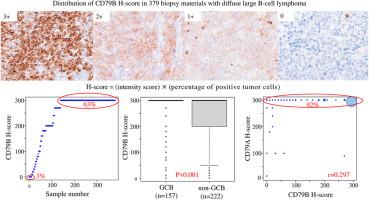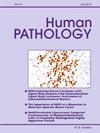Correlation with CD79B expression and clinicopathological parameters including cell of origin, CD79A and CD19 expression, and CD79B mutation in diffuse large B-cell lymphoma
IF 2.6
2区 医学
Q2 PATHOLOGY
引用次数: 0
Abstract
CD79B, the target of polatuzumab vedotin—an anti-CD79B antibody-drug conjugate—has shown greater efficacy in activated B-cell-type diffuse large B-cell lymphoma (DLBCL) than in germinal center B-cell (GCB) type. However, the correlation between CD79B expression and the clinicopathological parameters in DLBCL remains unknown. We evaluated CD79B expression using the H-score (range: 0–300) in 379 samples from 280 patients with DLBCL. Low CD79B expression (H-score ≤100) was observed in 48 samples (13 %), with 11 samples (3 %) showing no detectable expression. Notably, CD79B expression was significantly lower in the non-GCB type than in the GCB type (P < 0.001). Low CD79B expression correlated with advanced stage (P = 0.013), CD5 positivity (P = 0.014), and immunoblastic type (P = 0.067). Among the 48 DLBCL samples with low CD79B expression, 90 % demonstrated high (H-score >100) CD79A and CD19 expression. No mutation in the first tyrosine residue of CD79B immunoreceptor tyrosine-based activation motif, Y196, was identified in DLBCL with low CD79B expression. Additionally, low CD79B expression was not associated with the co-occurrence of CD79B ITAM and MYD88 L265P mutations (P = 0.748). Of the 78 patients with multiple biopsy specimens obtained from multiple sites or recurrent tumors, a change in CD79B expression from low to high or verse versa was observed in 9 % of patients. In conclusion, CD79B expression was lower in the non-GCB type than in the GCB type. CD79B, CD79A, and CD19 expressions were not completely correlated, and one expression cannot predict the others. In 9 % of patients, CD79B expression was inconsistent in multiple biopsy samples.

弥漫性大b细胞淋巴瘤中CD79B表达与临床病理参数(包括起源细胞、CD79A和CD19表达、CD79B突变)的相关性
polatuzumab vedotin的靶点CD79B -一种抗CD79B抗体-药物偶联物-在活化b细胞型弥漫性大b细胞淋巴瘤(DLBCL)中比在生发中心b细胞(GCB)型中显示出更大的疗效。然而,CD79B表达与DLBCL临床病理参数之间的关系尚不清楚。我们在280例DLBCL患者的379个样本中使用h评分(范围:0-300)评估CD79B表达。48份(13%)样品中CD79B低表达(H-score≤100),11份(3%)样品未检测到表达。值得注意的是,非GCB型的CD79B表达明显低于GCB型(P100)的CD79A和CD19表达。CD79B免疫受体酪氨酸激活基序Y196的第一个酪氨酸残基在CD79B低表达的DLBCL中未发现突变。此外,CD79B低表达与CD79B ITAM和MYD88 L265P突变的共同发生无关(P=0.748)。在78例从多个部位或复发肿瘤获得多个活检标本的患者中,9%的患者观察到CD79B表达从低到高或反之。综上所述,CD79B在非GCB型中的表达低于GCB型。CD79B、CD79A和CD19的表达不完全相关,一个表达不能预测其他表达。在9%的患者中,CD79B在多个活检样本中的表达不一致。
本文章由计算机程序翻译,如有差异,请以英文原文为准。
求助全文
约1分钟内获得全文
求助全文
来源期刊

Human pathology
医学-病理学
CiteScore
5.30
自引率
6.10%
发文量
206
审稿时长
21 days
期刊介绍:
Human Pathology is designed to bring information of clinicopathologic significance to human disease to the laboratory and clinical physician. It presents information drawn from morphologic and clinical laboratory studies with direct relevance to the understanding of human diseases. Papers published concern morphologic and clinicopathologic observations, reviews of diseases, analyses of problems in pathology, significant collections of case material and advances in concepts or techniques of value in the analysis and diagnosis of disease. Theoretical and experimental pathology and molecular biology pertinent to human disease are included. This critical journal is well illustrated with exceptional reproductions of photomicrographs and microscopic anatomy.
 求助内容:
求助内容: 应助结果提醒方式:
应助结果提醒方式:


